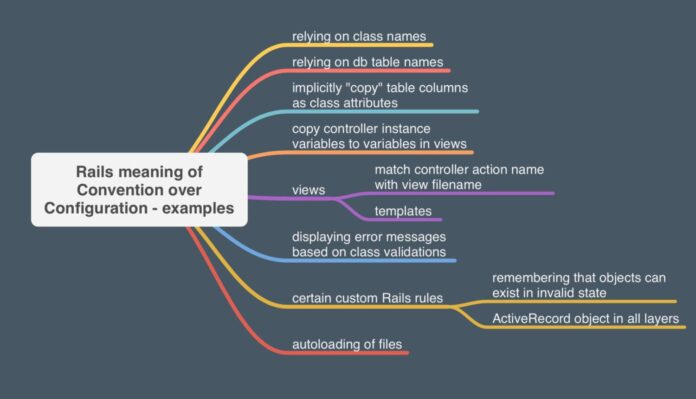In the ever-evolving landscape of web development, where numerous frameworks and programming languages continuously vie for developers’ attention, Rails has steadfastly maintained its reputation as one of the most popular and enduring frameworks for over a decade.
But what makes Ruby on Rails stand out? Why has it stood the test of time while consistently winning the hearts of countless developers and businesses? The answer lies in its exceptional ability to streamline the web development process, enabling faster, more efficient builds with significantly less code.
In this comprehensive exploration, we will explore the reasons behind Rails’ enduring popularity and how it continues to be a formidable choice in web development.
Convention Over Configuration
At the core of Rails’ philosophy is the “Convention Over Configuration” (CoC) principle. This foundational concept is a testament to Rails’ ability to simplify the development process by providing a set of predefined conventions. These conventions liberate developers from the tedious task of making an abundance of decisions regarding the architectural setup of their applications.
For instance, if your database table is named “articles,” Rails will intuitively search for a class named “Article” to establish the connection, eliminating the need for extensive boilerplate code. Developers can now focus their energy on coding the application without the encumbrance of intricate configuration setups.

DRY Principle
Another cornerstone of Rails is the “Don’t Repeat Yourself” (DRY) principle. This fundamental doctrine underscores the importance of having a singular and unmistakable representation for every piece of knowledge or logic within the system.
By adhering to this principle, Rails minimizes redundancy in code, ensuring that any necessary changes can be made in one centralized location. This approach significantly reduces errors and enhances the overall maintainability of the codebase.
Mature and Vibrant Community
Rails boasts a vibrant and thriving community that has evolved in tandem with the framework itself. This extensive network of developers, enthusiasts, and experts ensures that a plethora of resources is readily available to support anyone seeking to learn or harness the power of Rails.
From an abundance of tutorials, blogs, forums, and books to a vast ecosystem of Gems (Rails’ library packages) catering to virtually any functionality requirement, the Rails community serves as an invaluable resource. This robust support structure expedites the learning curve for beginners and offers a safety net for experienced developers navigating complex challenges.
Integrated Testing
Testing is seamlessly integrated into the Rails framework. When working with Rails, you benefit from a built-in testing suite that actively encourages and facilitates test-driven development (TDD).
This approach not only fosters a culture of rigorous testing but also ensures that potential bugs and issues are identified and rectified early in the development cycle, thereby enhancing the overall reliability of the application.

RESTful Architecture
Rails staunchly promotes the adoption of Representational State Transfer (REST) architectural principles. This approach simplifies user-friendly URL design and streamlines CRUD management (Create, Read, Update, Delete) operations.
Aligning with industry best practices in web development, this structure facilitates the creation of more intuitive and maintainable application designs.
Agile Development
From its inception, the Rails framework was not just built as another tool in the developer’s toolbox. Instead, it was meticulously crafted to align with and amplify the principles of agile development methodologies. This dedication to agility is evident in the wealth of features, utilities, and tools that Rails provides, all tailored to support the swift evolution of projects and to adapt to shifting requirements effortlessly.
At the heart of Rails’ agility is its powerful database management system. Through migrations, developers are empowered to make changes to the database schema without the need to reconstruct or jeopardize existing data manually. This ensures that as projects evolve, the underlying data structures can adapt in tandem without causing disruptive hiccups in the development process.
Another cornerstone of Rails’ adaptability is the asset pipeline. This tool seamlessly manages front-end assets like JavaScript, CSS, and images. Optimizing and serving these assets efficiently it ensures the front end remains as dynamic and responsive as the back end, thereby creating a harmonious and efficient development environment.
Scalability
While some skeptics have argued that Rails may not be suitable for very large applications, this assertion has been debunked by numerous high-traffic sites. Platforms like GitHub, Airbnb, and Shopify have successfully utilized Rails to handle the demands of massive user bases with proper architecture and optimization. This dispels the myth of Rails’ scalability limitations, affirming its ability to power large-scale applications effectively.

Comprehensive Framework
Rails stands out as a full-stack framework, encompassing front and backend development tools within its ecosystem. This comprehensive approach eliminates the need for developers to cobble together disparate tools and technologies. Consequently, developers can craft a more cohesive and unified development experience that spans the entire web application.
Active Record ORM
Rails introduce the Active Record Object-Relational Mapping (ORM) system, simplifying database interactions. With Active Record, developers can interact with databases using Ruby without crafting intricate, error-prone SQL queries. This abstraction layer leads to more readable and maintainable code, elevating the overall quality of the application.
Continuous Innovation
Despite its substantial longevity in web development, Rails still needs to grow. The Rails community and core development team continue to drive innovation within the framework, ensuring it remains abreast of the latest trends and best practices in web development.
This commitment to continuous improvement empowers developers to leverage modern techniques and technologies in their projects while benefiting from Rails’ stability and reliability.

Conclusion
Its unwavering emphasis on convention, commitment to the DRY principle, and vibrant and supportive community make it an exceptional choice for developers who embark on their web development journey or are seasoned experts in the field. If you want to streamline your web development process, Ruby on Rails is the solution you’ve been searching for. Its enduring popularity and proven track record make it a compelling choice for those who value efficiency, maintainability, and the power of community support in their web development endeavors. With Ruby on Rails, you not only build web applications; you build them with the confidence and agility needed to succeed in today’s fast-paced digital landscape.









